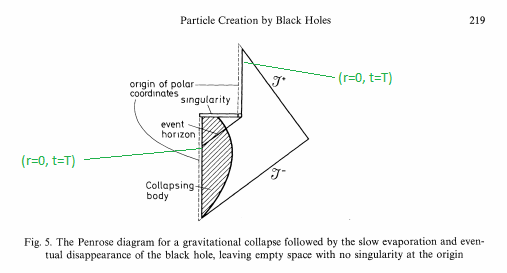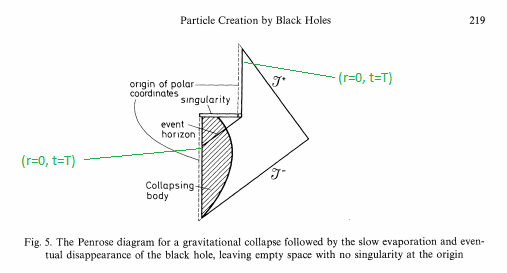

rjbeery
Senior Members-
Posts
142 -
Joined
-
Last visited
Content Type
Profiles
Forums
Events
Everything posted by rjbeery
-
That's a distinction without a difference, and you have your logic backwards -- cosmic rays have no known nor plausible mechanism that might limit their incoming velocity as they enter our atmosphere. The energy required for a cosmic ray to collapse into a black hole isn't ungodly (due to their radius). To acknowledge cosmic rays but deny micro black holes is tantamount to declaring GR wrong. Possible, but I'm not here to convince others; I'm here to listen to and analyze objections.
-
This is why I put the emphasis on micro black holes -- GR predicts them, yet the fact that we can't detect them implies (almost demands) that evaporation of some sort occurs. That this evaporation must occur prior to the event horizon existing, on logical grounds, is what I've been unable to convey in this thread.
-
I'm referring to coordinate time (i.e. the infinite observer) when I make the statements below. In my experience there can be a tendency in forums to obfuscate through complexity, or at least unintentionally over-complicate a problem. Looking at the Schwarzschild solution for a black hole of radius zero should make it obvious that any sort of evaporation leads to a contradiction.
-
Well if that's an argument then the singularity is necessary as well. 😜 There's no need to do this because my objection involving the event horizon using Schwarzschild coordinates only concerns the exterior region. All finite space and time have been accounted for. Every point (r=0, t<infinity) is represented, mathematically and physically, prior to the event horizon's creation. This has a literal, physical meaning. This mathematical fact does not vanish by changing coordinate charts or imparting angular momentum.
-
This is a matter of fact, and I'm baffled that we're even on this subject. All of GR is designed to be coordinate invariant, and the ordering of events is obviously an absolute feature of physics. If different results are given in different analyses it's probably because they have altered the time and space definitions for mathematical convenience. An observer hovering just above the event horizon would witness the infinite future, but an infalling observer has his gravitational effects counter-balanced by his relative velocity, and the net result is a redshifting. If memory serves, he would see distant clocks ticking "at half speed" as he passes the event horizon.
-
I'm not bothered by the notion of "no causal connection" but you cannot say that an event within the black hole "doesn't exist in the coordinate space". That's nonsensical. The entire point of this coordinate system is to give unique, well-ordered labels to events in spacetime.
-
Wait a minute. That is literally the purpose of Penrose diagrams -- to follow causality through and beyond the event horizon. To say "it isn't meaningful" is the same thing as proclaiming that Penrose diagrams aren't meaningful.
-
Then you agree that an observer residing in the upper part of Hawking's diagram (after the evaporation) has a coordinate time less than the time represented by any point residing at r=0 between the event horizon and the singularity below it on the graph?
-
Some of these comments are presuming the existence of the event horizon, first, and then leaning on the definition of them as a defending explanation of them. Please refer to the diagram to see my objection. The formation of event horizons takes an infinite amount of coordinate time. We can map this using Penrose diagrams, where the top of the customary diagram represents the "infinite future". When we attempt to use a Penrose diagram to illustrate events after an event horizon has formed, we are now showing spacetime coordinates (events) which have already occurred, and have been accounted for. (r=0, t=100) is represented twice in the diagram, for example.
-
Agreed, but I'm talking about a specific observer who is located at a point in space which "used to" contain a black hole. The black hole resides in the past of this observer. If you can't see the contradiction here, please refer to the diagram.
-
The diagram is from page 219 of Hawking's "Particle Creation by Black Holes" paper. The causality issue is why Penrose diagrams are useful. I'm claiming that what Hawking did with them is not mathematically valid. The vertical axis is the time parameter, and either his diagram shows a black hole forming (and evaporating) in finite coordinate time, which is not supported by any mathematics of GR, or he is showing events that occur after the infinite future (i.e. higher on the vertical axis).
-
It's the section in the past of our spacetime diagram where a theoretical black hole temporarily existed. The original way I showed the problem was this: The left vertical axis is the origin, r=0. This black hole is created and then eventually evaporates. Hawking wanted to represent the space r=0 after the black hole had dissipated, but you cannot normally do that with a Penrose diagram because timelike infinity is represented at the top. To see that this is a problem, consider the coordinate of the black hole completing its evaporation at t=100 in coordinate time. The point (r=0, t=100) is represented both at the event horizon formation and also after the black hole is gone.
-
This is fair, we all appear to agree that finite black holes demand an "island" of spacetime which can be located in our past light cones, but whose interior contains points which are not. You both seem to feel that this is OK, and my feeling is that this "island" is no longer on a differentiable manifold when it becomes disconnected from the traditional future null infinity (the infinite future according to us).
-
Being in my past is exactly the problem. It's directly contradicts the descriptive definition of event horizons and black holes. The problem isn't GR; it's GR + some process that makes black holes finite (in this case, evaporation). Event horizons and finite black holes are mutually incompatible, and since we agree that black holes require an event horizon then the very term "finite black hole" is an oxymoron.
-
GR's treatment of gravity already accounts for stellar motions and accretion discs without requiring event horizons. It's entirely possible that black holes exist, but then it's also possible that the center of galaxies are full of unicorns and lemon ice cream. If GR has "a number of failings with regard to BHs" then you have no model whatsoever to predict them.
- 128 replies
-
-2
-
From our perspective, the points beyond the visible universe are within the "black hole" that you're referring to, which is fine. That definition would be broken if we could somehow reach those locations at some point in the future, which we cannot (unless cosmic expansion reverses at some point?) That's the exact problem with "local" black holes. We can literally travel to the location of their existence and wait for them to evaporate. That entire region is now wholly within our past light cone. GR demands that spacetime is a differentiable manifold so we can't simply proclaim that this "remote island of spacetime" exists in our past but somehow has eluded existing in our causal past. It does put them in our past. The earliest reference to this concept that I can find is in Hawking's paper. Below is the graphic used, and a visualization of the problem (in green).
-
One of the more common definitions of black holes is a variation on The above is pulled from here and is credited to Robert Wald. My issue is that this, and almost any, definition makes finite black holes a logical impossibility. In other words, any process (e.g. Hawking radiation, which I generically refer to as "evaporation"') that eventually eliminates the event horizon has, by the definition of black holes, negated that black hole's existence for all time, including the past. Evaporation and event horizons are mutually exclusive ideas. To make this point clear, imagine the hypothetical micro black holes (MBH) forming in our atmosphere due to cosmic rays. They form, let's say in our physics lab on some random night, and almost immediately decay (as declared by the authors of the LHC Safety Assessment Group paper): We come back the next morning and have equipment that recorded the MBH's existence. We can also verify that the MBH no longer exists. This clearly puts the entire history of this MBH in our causal past, and CERTAINLY in the causal past of future null infinity. That region in spacetime of our lab containing this theoretical MBH cannot have included an event horizon. This, of course, applies to black holes of any size and any arbitrarily long, but finite, evaporation time. We can always travel to the region in space where the black hole "used to exist" and declare that region to be completely within our past light cones, contradicting the notion that an event horizon ever existed there in the first place.
-
Understood. The following is from page 3 of the LHC Safety Assessment Group report which was made prior to the Large Hadron Collider's construction. I assume we can all agree that this paper has been sufficiently vetted and generally reflects a consensus of the physics community regarding black holes, micro black holes, Hawking radiation and the "basic physical principles" on which those objects are predicted. I'm just trying to nail down exactly what we're talking about before I relay my issue with black holes, because in my experience people can get a bit "hand-wavy" on the subject. This is great. So if a space contains no event horizon then we will agree that it does not contain a black hole?
-
I have some problems/questions regarding the existence of black holes. First, here is the current state-of-affairs in the physics community AFAIK: Black holes "exist" in the sense that they are physical objects in the Universe Black holes contain an event horizon, located at the Schwarzschild radius, beyond which "nothing can escape" Black holes are likely located at the center of many galaxies, including our own; "micro black holes" are also likely formed and quickly evaporate in our atmosphere due to relativistic cosmic rays Quantum mechanics is anticipated to resolve any mathematical singularity issues at the center of black holes There are a variety of theories, most notably Hawking Radiation, that predict an "evaporation" of black holes over extraordinarily long periods of time Does anyone feel this any of these statements are inaccurate?
-
I have some questions regarding black holes. Which forum channel would be appropriate, and do we happen to have any astrophysicists on this forum?
-
Markus, may I ask your profession?
-
Agreed. I'll post to the forum if and when I find or produce a new analytic solution. Thanks so much for the patient and mature discussion.
-
Have you actually read the OP? Or its references? Did you look at the numeric analysis I posted? I shared the spreadsheet so you can see that there are no fudge factors involved. The math works. That being said, I understand the tensor objection, which is why I'm asking for real-world examples where spacetime curvature and time dilation diverge. Maybe the full time dilation field requires more information than I'm presuming; maybe GR has redundancies in distinguishing mass/momentum and other forms of energy (IOW, two different systems could produce the same result); maybe there's more information in the EFEs than mere spacetime curvature; maybe this connection doesn't generalize and is only useful in limited analyses. I think about all of these things. But insisting that either this idea can either immediately and completely replace all of GR, or else it's worthless, seems premature.
-
Feel free to throw out thoughts, I love hearing other perspectives. Dispersion and FLRW are things I had never considered, and I appreciated their mention.
-
Markus, I understand your position and I appreciate your input. You're correct that I keep referring to the simpler Schwarzschild spacetime solution but that was to illustrate the theoretical connection to others who can't see it at all. I'm "facing many fronts" in this thread. I just spent 6 hours convincing another poster that the gravitational time dilation equation is mathematically valid. You might be right that the connection doesn't generalize, but I remain unconvinced. The FLRW spacetime example doesn't work, for example - the reason we know about cosmological expansion in the first place is due to time dilation (red-shifting of the distant stars). In fact, when people present me with apparent counter-examples that I can explain it does nothing but strengthen my resolve. If that's frustrating, I'm sorry. This is right but we've already covered it. It's the local time dilation gradient that determines gravitational movement. Remember discussing Newton's shell?


